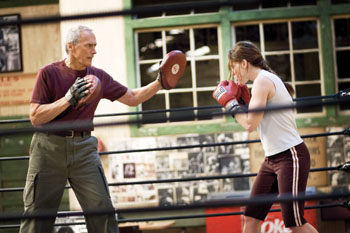![[Metroactive Movies]](/gifs/movies468.gif)
[ Movies Index | Show Times | Santa Cruz | Metroactive Home | Archives ]
Tough Glove: Clint Eastwood shows Hilary Swank the ropes in 'Million Dollar Baby.'
In the Cut
Clint Eastwood's boxing picture 'Million Dollar Baby' has a heart of caramel underneath the body armor
By Richard von Busack
When Clint Eastwood makes a sturdy film, expect it to be called a masterpiece, even if it's essentially just a boxing picture in good shape. Eastwood is at his most sure-footed when he has a propulsive script without too many treacherous subtleties.
Understatement isn't quite the same thing as subtlety. As Sergio Leone put it, when Eastwood starts to act, the visor comes down. Eastwood's hard-shell remoteness is something the movies have conditioned us to love; he looks like he has integrity, and we know there's a heart of caramel underneath the armor.
Million Dollar Baby isn't an agonized misreading of a novel about the ruinousness of the Irish-thug code, as Mystic River was. In his previous film, Eastwood wreaked a celebration of a man's duty to kill out of a bitter thriller of wasted, limited lives and too-long memories. If critics are calling Million Dollar Baby a better movie than Mystic River, maybe what they mean is that the crosscurrents don't confuse them as much.
In plain, Eastwood isn't out of his depth in Million Dollar Baby, but he makes the same old shallow ideas look eternal. He honors the cleanliness of violence, probing the cuts and drinking in the knockout punch.
Paul Haggis based this screenplay on a short story from F.X. Toole's Rope Burns, a terse and knowing book about boxing. (Toole was a boxer and a "cut man"--the ringside assistant who staunches the bleeding so a boxer lasts till the end of the fight.)
The Million Dollar Baby of the title is a female palooka named Maggie (Hilary Swank), who seeks training from a reluctant manager, Frank Dunn (Eastwood). Frank refuses to get Maggie started on the grounds that he won't train girls--that at 31, she's too old to start. Once he finally gives up, he recognizes her champion qualities. She can't dance, but she has a lethal punch. Still Frank is fearful. He won't get Maggie into the fights she wants, because he thinks she's still unready. Though Maggie eventually becomes a big-money fighter, Dunn's fears of disaster turn out to be right.
Swank's simple, tough girl has dignity. The scenes of Maggie's waitress life are authentically funky: she wipes a blot of steak sauce off a dollar bill left as a tip and tinfoils up some unfinished meat from a diner's plate to take home to eat ("for my dawg"). The Hit Pit gym, designed by veteran production designer Henry Bumstead, is as dark and scuzzy as an Ed Kienholz installation. But in its shadows, Swank looks like a thoroughbred pulling a plough. Why this gym, why this manager?
There probably isn't a film that couldn't be smoothed by Morgan Freeman's honorable old voice narrating it. Freeman plays Scrap the janitor. Scrap expresses the feelings that Dunn won't show, tall piece of gristle that he is. We know Dunn's melting heart, though. He prays on his knees; he reads aloud Yeats' "The Lake Isle of Innisfree." And he writes letter after letter to his daughter, who never writes back.
It's an effective film. Eastwood knows how to sucker-punch an audience with a deathbed scene: right at the point of death, he mutters the answer to a Gaelic riddle he has posed throughout the movie. But would a masterpiece have included the comic-relief instances of Frank bandying with a priest about the Holy Trinity? Whenever anyone sassed one of Barry Fitzgerald's priests in the 1930s, it was mildly sacrilegious then, too.
The episodes with Maggie's hillbilly family are embarrassingly directed; so lazy that even though the scenes are supposed to be set in the Ozarks, we can see a yucca in the frame. And when Maggie does her family a huge favor, her mother cries that the government will take away her welfare check. Eastwood's celebrated populism only goes so far. And he's still thrashing the Commies. Even though the fighter Swank goes up against is black, she's supposed to be a killer from "East Germany." Is she the daughter of the remorseless Russki that Dolph Lundren played in Rocky IV?
It's no shame to be repulsed by violence. And what's so sweet about the sweet science? This throwback to the Irish days of boxing works the religious angle, as the movies have for decades, and as in The Passion of the Christ: He took a beating. Can you? How much admiration Million Dollar Baby deserves depends on how much you can submit yourself to the tunnel vision of the coach, as well as to the legend of Eastwood, as he'd love to see himself: as an unquestioned old man, who has by his side a woman that knows enough not to question him--who always calls him "Boss."
[ Santa Cruz | Metroactive Central | Archives ]
Copyright © Metro Publishing Inc. Maintained by Boulevards New Media.
For more information about Santa Cruz, visit santacruz.com.
![]()

Photograph by Merie W. Wallce
Million Dollar Baby (PG-13; 134 min.), directed by Clint Eastwood, written by Paul Haggis, photographed by Tom Stern and starring Eastwood, Hilary Swank and Morgan Freeman, opens Friday at selected theaters countywide. Metro Santa Cruz staff writer Richard von Busack also appears on Santa Cruz Community Television's 'CinemaScene.'
From the January 5-12, 2005 issue of Metro Santa Cruz.